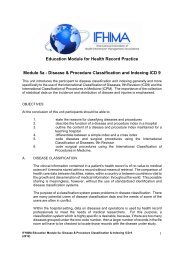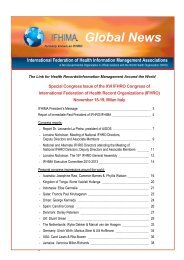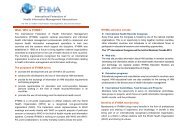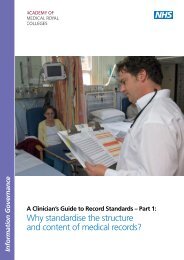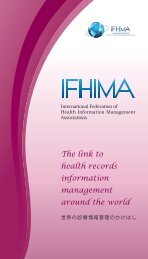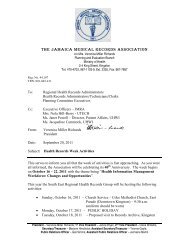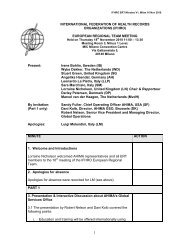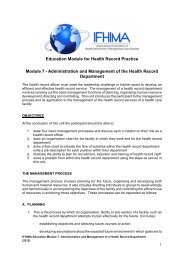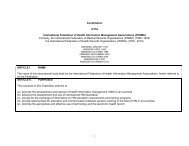Learning Packages for Medical Record Practice - ifhima
Learning Packages for Medical Record Practice - ifhima
Learning Packages for Medical Record Practice - ifhima
Create successful ePaper yourself
Turn your PDF publications into a flip-book with our unique Google optimized e-Paper software.
)<br />
responsible. If the registration staff assign the health record numbers,<br />
predetermined blocks of numbers are often issued to patient registration<br />
areas having a high volume of new patients. The amount of numbers in<br />
each "block" should be determined by the activity of each area and<br />
should be limited and carefully controlled. Since each area is allocated a<br />
specific block of numbers, duplicate numbers should not be assigned.<br />
Computerized system<br />
The best system <strong>for</strong> number assignment exists in facilities having<br />
computerized registration and unit numbering. With computerized<br />
registration, number assignment in every registration area is possible<br />
because computer systems are available to check the MPI and to verify<br />
that the patient does not have an existing medical record number. As the<br />
patient is registered, the staff searches the computerized MPI database<br />
to determine if the patient has already been assigned a unit number. If<br />
so, the demographic in<strong>for</strong>mation is updated as necessary and the current<br />
visit in<strong>for</strong>mation is entered. It is important to note, however, that if more<br />
people are responsible <strong>for</strong> assigning numbers, the risk of duplication will<br />
increase.<br />
4. Number control<br />
It is important in both manual and computerized systems to have an<br />
established method of number control. Numbers should not be pre-assigned<br />
unless good control processes are in place.<br />
In a manual system, this can be a permanent number index, or master<br />
control book, where all assigned and unassigned numbers are held. As a<br />
number is allocated the name of the patient is immediately entered beside<br />
that number. Date of issue is also recorded.<br />
For example:<br />
Number Name Date Where issued<br />
102642 Brown, John 09/27/2004 Outpatient Department<br />
102643 Miles, Andrew 09/27/2004 Outpatient Department<br />
102644 West, Julia 09/27/2004 Admission Office<br />
In computerized systems, a check digit is determined by per<strong>for</strong>ming some<br />
calculations on the basic number. Thus, check digit verification is a way of<br />
detecting errors, caused by transcription of a data field or transposition in the<br />
use of the number. It contains in<strong>for</strong>mation about the magnitude and the<br />
position of each digit in the field. Transcription (a wrong digit) or<br />
transposition (two digits reversed) errors lead to a calculation result, different<br />
from the check digit, and there<strong>for</strong>e an error message will be printed.<br />
IFHIMA Education Module 3: <strong>Record</strong> Identification Systems, Filing and Retention of Health <strong>Record</strong>s<br />
(2012)<br />
9



